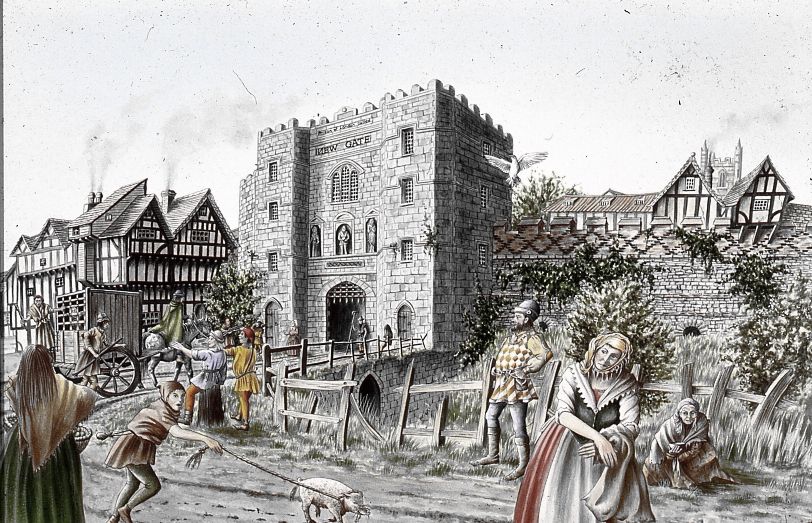The Decline And Fall Of Roman London Walk 11.30pm Sat 8th Nov 25 To book
Jane Austen’s London Anniversary Walk 2.00pm Sat 8th Nov25 To book
Jane Austen’s London Anniversary Virtual Walk 7:30pm Sat 8th Nov25 To book
The Rebirth Of Saxon London Archaeology Walk 11.30am Sun 23rd Nov 2025 To Book
Jane Austen’s London Anniversary Walk 2.00pm Sun 23rd Nov25 To book
Jane Austen’s London Anniversary Walk 2.00pm Sun 14 Dec25 To book
Christmas With Jane Austen Virtual London Tour 7.30pmTues 16 Dec25 To book
Charles I and the Civil War. Martyrdom Anniversary Walk Jan 30th 2026 To book
For a complete list of my guided walks for London Walks in 2025 look here
Halloween October 31st
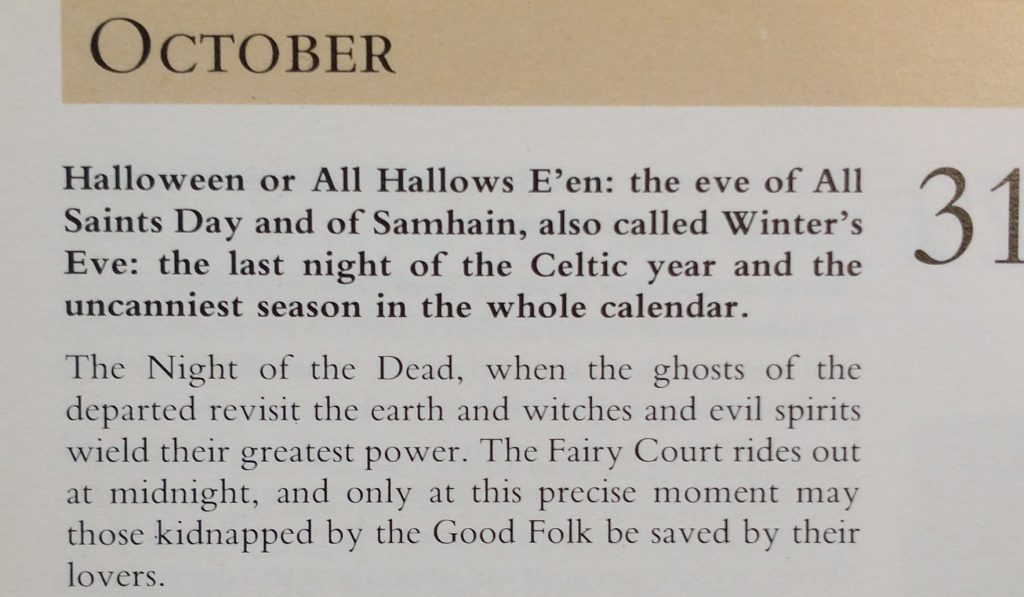
I began my perpetual Almanac of the Past four years ago on the 31st October 2021. This was the first line:
‘This blog is to celebrate the Year. I will post, hopefully, once a day, so we can follow the seasons, as they happen naturally, and as people in Britain and Ireland have responded to the changes in the year.’
It was inspired by Charles Kightly’s book, which is a pot-pourri of folklore taken mostly from old Almanacs. I haven’t managed, yet to create a post for every day of the year, nearly managed it in the winter but falling behind in the Summer when I take Road Scholar groups around the UK. My plan is to fill in the gaps, improve posts and get rid of typos. Another aim is to add more London-specific content.
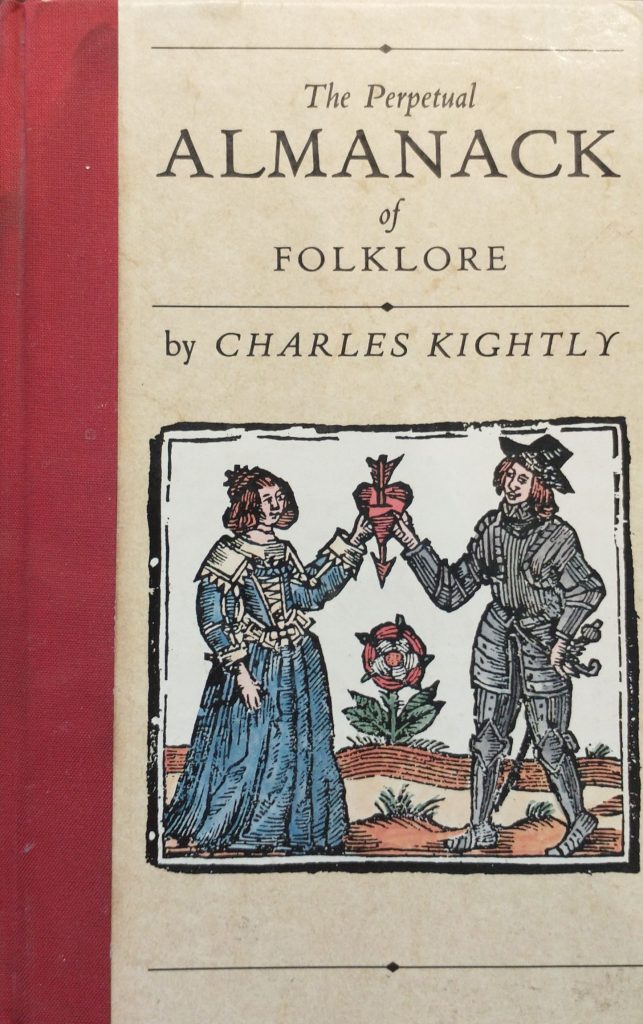
I started on Halloween because Samhain (pronounced Sow-in) was the beginning of the year for the Celtic world. It may mean Summer’s End. In Wales, it is Calan Gaeaf (first day of winter) and Kala Goafiv (beginning of November in Brittany).
Why did the Celts start their year at such an unlikely time? A clue is that they began the next day at dusk. The Sun dies at dusk so it is the end of the day, and the next day begins with the death of the old day.
So the New Year begins with the Death of the Old Year. Now that might suggest the Winter Solstice as the best time to start the year as this celebrates the death of the old Sun. (see my winter solstice post here :) But, the end of October has, perhaps a better claim. The harvest is in, the fruits in the trees and the nuts are harvested, all the growth of the Summer is over and collected. Plants are mostly dead or dormant, except some evergreens. It is the end of the growing year. The seeds have fallen from the trees and shrubs and are nestling in the soil, ready to begin their cycle again. All is over and all is ready for the new year. Makes sense?
The Celtic way also explains eves; Christmas Eve, New Year’s Eve, May Eve, All Hallow’s Eve. They are not the night before the day, they are the beginning of the day. This is when you begin the celebration.
For the Romans, today is the day that Adonis is injured hunting a wild boar. Against his lover’s (Venus) advice, he descends to the underworld. Nature withers and dies until he returns from the underworld. His blood stains a flower and was transformed into the Crimson Anemone. There is a similar story in Babylon of Ishtar and Tammuz.

Binyon 1898-1907 / Catalogue of drawings by British artists, and artists of foreign origin working in Great Britain (5(c))
Adonis comes back on May Day when he meets Venus again, so the world flourishes and is bright and warm.
Julius Caesar says the Gauls venerated the God Dis Pater on this day – an aspect of Pluto, the God of the Underworld, ruler of the Dead. There was a Roman Festival on the Kalends of November dedicated to Pomona, the goddess of the fruit of trees. This may influence the use of Apples, which are prominent in Halloween festivities.
For more about the origins of Halloween, please look at my post on All Hallows Day here:
First written in 2021, and revised 2023, 4 and 5.
Douai Martyrs Saints Day October 29th

Today, is the feast day of 158 English Martyrs from the English School at Douai. They were killed by the English state between 1577 and 1680.
On the accession of the Protestant Queen Elizabeth, Catholics who preferred exile gathered in Douai (125 Kilometres South of Calais). An English School was set up, which was in essence a Catholic Oxford College in Exile. Its mission became to train priests to re-enter England and minister to the many Catholics who wanted to continue to practice their faith despite official intolerance.
Catholic worshippers were fined if they did not attend Church of England services in their local churches. Catholic Priests re-entering England could be charged with High Treason and, if found guilty, hanged, drawn and quartered. This was often at Tyburn (at the west end of Oxford Street in London).
In the short reign of Mary I, nicknamed ‘Bloody Mary’, over 250 protestants were burned at the stake for heresy. In the long reign of her sister, Elizabeth I, over 300 Catholics were executed for Treason by being Hanged, Drawn and Quartered. Elizabeth is known as ‘Good Queen Bess’. There is no value in balancing evil, but pro-rata Mary’s reign was much more bloody. Elizabeth would probably also suggest that she did not execute Catholics because of their belief, but because the policy of the Catholic Church was to destroy Elizabeth’s regime. So, the Priests were not executed for heresy but for treason. However, this is a fine distinction to be made, in such horrendous blood-letting.
The number of martyrdoms from one institution shows incredible bravery in the face of intolerance, and the Douai Martyrs were a remarkable group of people. Most have been beatified by the church, some have been made ‘venerable’, twenty have been canonised. A few remain simply as ‘martyrs’
In London in Ely Place is St Etheldreda’s Church, which has memorials to Catholic Martyrs, and no mention of Protestant Martyrs. A few hundred yards away in Smithfield is a plaque to the Protestant Martyrs under Queen Mary and no mention of the Catholic Martyrs. Personally, I think it is about time the two traditions made it clear that both groups of martyrs are worthy of equal distinction, and the authorities who allowed such toxic intolerance to triumph deserve our contempt.
Two examples of martyrs in Smithfield:
John Forest, a Franciscan Monk was burnt at the stake at Smithfield and commemorated in St Etheldreda’s Church. He was Catherine of Aragon’s Confessor, and refused to accept King Henry VIII as head of the Church of England.
John Rogers was a scholar and worked to continue William Tyndale’s work in translating the bible into English. He was the Vicar of the Holy Sepulchre Church, which is halfway between Smithfield and St Etheldreda. He was the first person to be burned during Queen Mary I’s reign, and mentioned on the memorial in Smithfield.
Thanks to my friend Derek, who suggested I cover this topic. His children went to a school in London named after the 158 English Martyrs,
For a longer look at the Protestant Martyrs at Smithfield have a look at my post which deals with the martyrdom of Thomas Thompkins a simple honest man burnt at the stake.
For more on St Etheldreda look at my post here.
First published in 2024, revised 2025
Wife-Selling & the bonds of Marriage October 1837
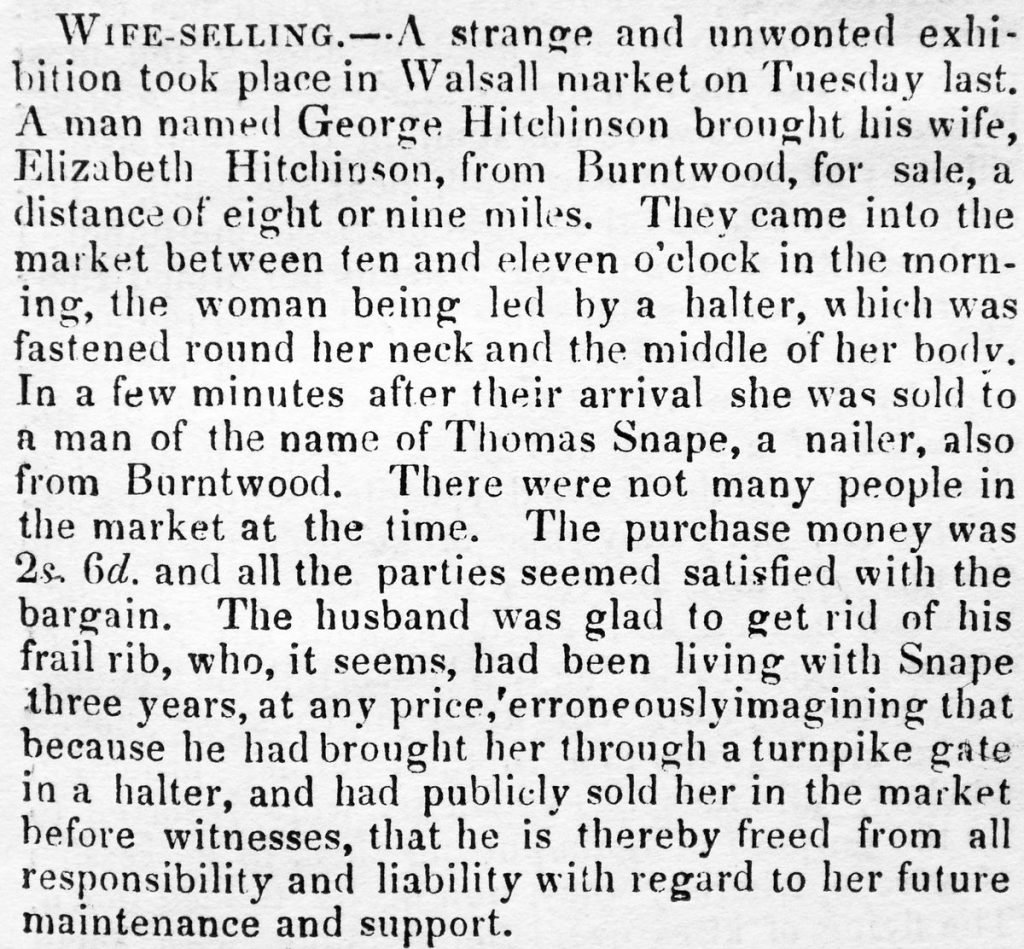
A strange and unwonted exhibition took place in Walsall market on Tuesday last,” the Wolverhampton Chronicle said about a case of wife-selling.
“A man named George Hitchinson brought his wife, Elizabeth Hitchinson, from Burntwood, for sale, a distance of eight or nine miles. They came into the market between ten and eleven o’clock in the morning, the woman being led by a halter, which was fastened round her neck and the middle of her body. “
“In a few minutes after their arrival she was sold to a man of the name of Thomas Snape, a nailer, also from Burntwood. There were not many people in the market at the time. “
“The purchase money was 2s 6d [about 13p today] and all the parties seemed satisfied with the bargain. The husband was glad to get rid of his frail rib, who, it seems, had been living with Snape three years, at any price, erroneously imagining that because he had brought her through a turnpike gate in a halter, and had publicly sold her in the market before witnesses, that he is thereby freed from all responsibility and liability with regard to her future maintenance and support.”
Wife-selling and the Mayor of Casterbridge
Readers will note the similarity of this to the plot of the Mayor of Casterbridge by Thomas Hardy, published in 1886. Michael Henchard, gets drunk on spiked Furmity. This is also known as frumenty – a mixture of Corn, milk, raisins and currents. The Furmity Woman at Weydon-Priors Fair adds Rum. Henchard, in a drunken rage, offers his wife for safe. She is purchased by Richard Newson, a sailor who goes on to have a successful relationship with Henchard’s wife until the sailor is drowned.
A cruel humiliation or a practical solution?
While not exactly legal, records show that wife-selling at markets happened occasionally from the 17th Century onwards. As in the case at Walsall Market, it seems to have been a recognised mechanism to end an unsuccessful marriage. In both factual and fictional cases, the wife accepts the sale to rid herself of a difficult husband. The husband is relieved of his lifelong duty to be financially responsible for his wife, and, for a fee, he passes that duty on to the buyer.
The sale seems to a modern onlooker to be a humiliation. But the public nature of it might be rather a public acknowledgement that the marriage has irrevocably broken down, and that another union has superseded the failed marriage. In the Walsall case, the new husband has, in fact, been living with the wife for some years.
At this time, there was no legal way to divorce except by the means of an expensive private Act of Parliament, far beyond the reach of any but the richest. Marriage itself was also a looser institution than we think. Hand-fasting and common-law marriages were very common in pre-Victorian times. The difficulty of divorce is also a theme in Hardy’s ‘The Woodlanders’.
A recipe for frumenty:
To make a rich frumenty for 10 people. Steep 1 lb of whole grain of wheat in water overnight, and then boil the steeped grains in one pint of milk until the whole be soft. Add thereto raisins and sultanas, honey a nutmeg freshly grated, a little cinnamon, brandy and cream: and serve it forty hot or cold.
Mistress Bartons Cookery book c1680. quoted in Charles Kightly’s Perpetual Almanac of Folklore
You might like to also see my post on the shaming skimmity ride, which also appears in the Mayor of Casterbridge.
On This Day
1415 St Crispin’s Day and the Battle of Agincourt.
This is part of the famous speech by Henry V, put in his mouth by William Shakespeare.
He that outlives this day, and comes safe home,
Will stand a tip-toe when this day is nam’d,
And rouse him at the name of Crispian.
He that shall live this day, and see old age,
Will yearly on the vigil feast his neighbours,
And say “To-morrow is Saint Crispian.”
Then will he strip his sleeve and show his scars,
And say “These wounds I had on Crispin’s day.”
Old men forget; yet all shall be forgot,
But he’ll remember, with advantages,
What feats he did that day. Then shall our names,
Familiar in his mouth as household words—
Harry the King, Bedford and Exeter,
Warwick and Talbot, Salisbury and Gloucester—
Be in their flowing cups freshly rememb’red.
This story shall the good man teach his son;
And Crispin Crispian shall ne’er go by,
From this day to the ending of the world,
But we in it shall be rememberèd—
We few, we happy few, we band of brothers;
For he to-day that sheds his blood with me
Shall be my brother; be he ne’er so vile,
This day shall gentle his condition;
And gentlemen in England now a-bed
Shall think themselves accurs’d they were not here,
And hold their manhoods cheap whiles any speaks
That fought with us upon Saint Crispin’s day.
First published in July 2022, revised and reposted October 2024 and 2025
The Miracle of the Testicles October 20th

I’m having technicals problems, as well as being away from home. I posted this a few days ago but it doesn’t seem to have been posted to subscribers. So posting it again.
Today, almost my favourite of many bizarre tales of Saints. St Artemios is the patron saint of male genital disorders, more specifically, hernias and ruptures. His Saint’s Day is October 20th St. Artemios was Governor of Egypt during the reign of Julian the Apostate (331 – 26 June 363). Julian was a philosopher. Nephew to Constantine the Great, who tried to turn the tide and return to traditional Roman religious practices.
Artemios was called to a military meeting with Julian where he witnessed and objected to abuse of Christians. He was tortured with red hot irons, and miraculously cured. Then he was taken to the Amphitheatre where there was a big stone broken in half. He was put on half stone and the other half was raised above him and released, crushing Artemios. He was presumed dead, and left for a day. But he was still alive, broken boned, disembowelled, eyeless and remained unwilling to renounce his religion. Julian ordered his beheading.
A noble woman took his body to Constantinople where his shrine soon started attracting miracles. In the 7th Century, an anonymous author compiled a record of the miracles. St Artemios had become known for healing hernias and genital disorders ‘mostly in men.’ I’m not sure entirely why. Perhaps because of the red-hot pokers? The disembowelling? Maybe the stone that crushed him was round?
I first came across the Saint when I was given a wonderful book called ‘A Medieval Miscellany‘. Tales are selected by Judith Herrin and with an introduction by the great Emmanuel Le Roy Ladurie (see Jan 27th Post to read about Montaillou and Ladurie). It had a colourful spread called ‘The Miracle of the Testicles’. This was the story told by Stephen, a 7th Century deacon of St. Sophia in Constantinople who ‘suffered a rupture, whether from shouting acclamations or from a heavy weight, I cannot say.‘
To cut a long story short, Stephen was very embarrassed by his condition. He tried many cures but finally undertook surgery. This was successful, but very soon the condition reoccurred which left him to despair.
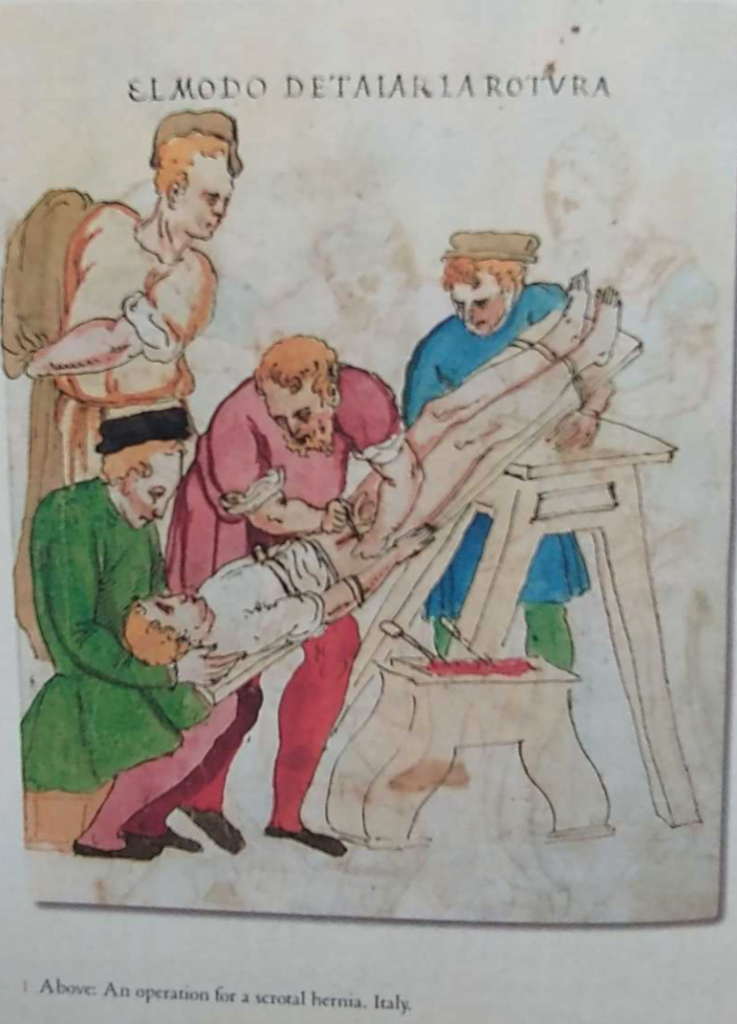
So he planned to visit the shrine of, Artemios, the great healer of testicles. However, he was too embarrassed to stand in the Church, ashamed to be seen by friends. But passing by one day he nipped into the Tomb, descended to where the relics were and ‘cast’ some of the Saint’s holy oil on his testicles. He then found, much to his surprise, that the doors to the Coffin itself were open. Seeing this as a divine intervention he jumped onto the coffin, straddled it face down, so that the corner of the tomb was rubbing his testicles and prayed:
‘And with tears, I spoke again to the martyr: “St.Artemios, by God, Who has given you the gift of cures, no doctor on Earth will ever touch me again. So if you please, cure me. But if not, to your everlasting shame I will live thus without cure.‘
He was not cured immediately. Later he went to the Hot Baths and bathed, and on leaving the baths, thanks be to St Artemios, he was completely cured.
I have transcribed the translation of Stephen’s writings and place it here below as it has many fascinating aspects and remember it is a 7th Century account. But what an extraordinary tale: that it seems reasonable to steal into a tomb, take the holy oil, rub your genitals all over the shrine, and then tell the Saint that it will be to his everlasting shame if he does not make the cure!
For more on the Hospital of Sampson click here. Livanon is one of the Roman Baths in Constantinople and it is interesting that the cure follows bathing in them. The Oxeia is a neighbourhood in Constantinople connected with St Antemios. A cautery is a method to remove or close off a part of the body. It can be hot, cold or chemical.
At long last I disclosed the misfortune to my parents, and after many treatments, (how many!) had been performed on me. Finally, after taking counsel with them, I entrusted myself for surgery to the surgeons in the hospital Sampson, and I reclined in the hospital room near to the entrance to the area devoted to eyes.
After I had been treated all over for three days at night with cold cauteries, surgery was performed on the fourth day. I will omit to what horrible things I experienced while on my back.
To sum up everything, I state that I actually despaired of life itself at the hands of the physicians. After God, entreated by the tears of my parents, restored my life to me, and after the scar from the incision and the cautery had healed, and just as I was believing that I was healthy, a short time later, the same condition recurred and so I reverted to my former state…
I had a plan to approach the holy martyr, as I had heard of his many great miracles. Still, I was unwilling to wait in the venerable church feeling ashamed before friends and acquaintances to be seen by them in such condition. But I frequently used to pass by (for at that time, I was staying in the Oxeia). And so I descended to the holy tomb of his precious relics, and I cast some of his holy blessing, I. e. oil on my testicles, hoping to procure a cure in this manner. And frequently, I entreated him to deliver me from the troublesome condition…
After descending to the holy tomb, I found the doors in front open and I was astounded that they were opened at such an hour. This was the doing of the martyr, in his desire to pity me, Stretching out facedown on the holy coffin, I straddled it, and thus contrived to rub the corner of the same Holy tomb on the spot where I was ailing. And with tears, I spoke again to the martyr: “St.Artemios, by God, Who has given you the gift of cures, no doctor on earth will ever touch me again. So if you please, cure me. But if not, to your everlasting shame I will live thus without cure.’ And after some days I went to the bath in the court of Anthemios, the one called Livanon to bathe by myself at dawn in order not to be seen by anyone . And entering the hot chamber, I noticed that I still had the injury. But upon exiting, I had no injury, and recognising the act of kindness on the part of God and the martyr which is befallen me… in thanksgiving… I do now glorify them proclaiming their deeds of greatness throughout my whole life.
From Medieval Miscellany selected by Judith Herrin Pg 54 the Miracle of the Testicles
First published in 2023, revised 2024 and 2025
St Etheldreda October 17th 679
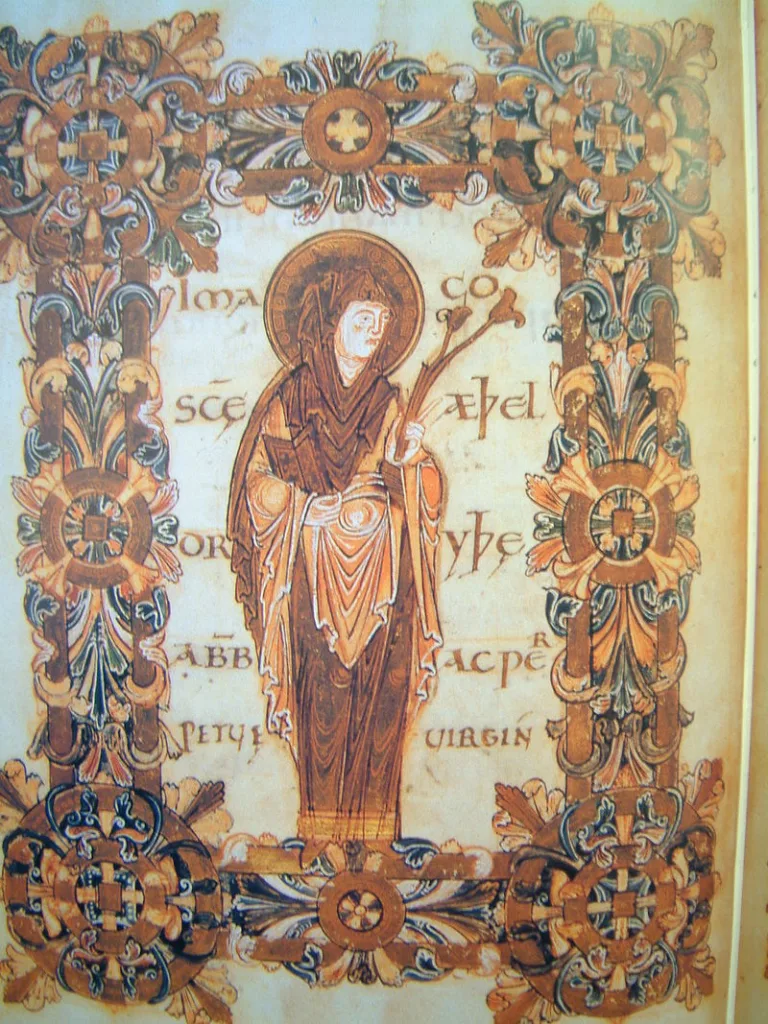
I’m republishing this post as I dated it to February 17th rather than October 17th and a few other egregious typos.
Etheldreda, also known as Audrey or Æthelthryth or Æðelþryð or Æþelðryþe is celebrated on October 17th, (the date her remains were ‘translated’ from her burial place to the Church at Ely) and on 23 June the date she died,
She lived from March 4th 636 to June 23rd 679. She is one of the well-born Saxon Virgin Saints of the 7th Century. This is when many royal Abbeys were founded by female members of the Anglo-Saxon Royal families, in the years following the conversion of the Anglo-Saxons to Christianity. She is the daughter of King Anna of East Anglia, and the sister of Saint Sexburga (widow of King Erconbert of Kent).
Etheldreda is said to be a Virgin despite being married twice. Etheldreda was widowed after three years of her first marriage. Then she married Egfrid, son of King Oswy of Northumbria. Egfrid got fed up with her virgin state. With the support of St Wilfrid, St Etheldreda was released to a Nunnery run by Wilfred’s aunt. In 672 she founded the famous double monastery at Ely, which is where the wondrous Cathedral of Ely still stands.
Here she died, and the many miracles that followed, led to Ely being one of the main destinations for Pilgrimages. St Sesxburga took over as Abbess after her death. By the number of Churches and holy days remembering Etheldreda show she was perhaps the most famous female saint of the era.
Tawrdy Audrey
Etheldreda died of a neck tumour, which she blamed on the heavy jewellery she wore around her neck before she became a nun. So she is a patron of those with neck or throat ailments. Accordingly, on February 3rd St Etheldreda’s Church in London holds the Blessing of the Throats ceremony. St Blaise is also a saint protecting the throat and you might like to read my post about him and throats here.
Pilgrims used to buy cheap, old-fashioned linen from the market at Ely, which they would wear around their neck to protect or cure them of throat illnesses. Puritans satirised the practice by coining the word Tawdry, from St Audrey, which came to represent cheap goods sold to gullible pilgrims.
Mopsa the shepherdess in Shakespeare’s Twelfth night says to her sweetheart:
“Come, you promised me a tawdry-lace and a pair of sweet gloves.
Have a look at this excellent article to read more about Tawdry and St Etheldreda.
However, I thought something was amiss and searched for Tawdry in the excellent website SHAKESPEARE’S WORDS by DAVID CRYSTAL & BEN CRYSTAL (which I use all the time). And indeed Mopsa is not in Twelfth Night but in the Winter’s Tale which I saw recently at the RSC. Mopsa’s man can’t buy it for her as he has been cheated out of his money by the fey Autolycus.
St Etheldreda’s Church in Ely Place London

St Etheldreda’s in London is in Ely Place, near Hatton Garden. There is a lovely old pub there called the ‘Ye Olde Mitre’ (which is a reference to a Bishop’s Mitre). The Church was founded (1250 and 1290) as the London residence of the Bishops of Ely. Inside are memorials to Catholic martyrs executed during the Reformation. (see my post on the Douai Martyrs here).
Ely place was lived in by John of Gaunt following the destruction of his Savoy Palace in the Peasants Revolt. Christopher Hatton rented parts of it in the reign of Queen Elizabeth II. During the Civil War it was used to hold Royalist Prisoners of War. Agnes Wicks fictionally lives at Ely Place. (Agnes is the woman David Copperfield should have married, rather than the ridiculous Dora).
In the 19th Century, the former Chapel was bought by the Catholic Church and restored by George Gilbert Scott.
Etheldreda is remembered in the Church of England with a Lesser Festival on 17 October according to Book of Common Prayer tradition, and alternatively 23 June in the Common Worship calendar of Saints. (Wikipedia.
First Published on October 17th 2025
Tally Sticks & Parliament burning down October 16th 1834

In 1834, the Government decided to end the use of Tally Sticks by the Exchequer and replace them with paper ledgers. They decided to burn the sticks that had been used to record financial transactions for six hundred years. Richard Weobley, the Clerk of Works decided not to give the Tallies to staff as firewood, but to burn them in two stoves below the House of Lords. The chimney was designed for coal not for wood, and it started a fire that destroyed virtually the entire Houses of Parliament and most of the ancient Palace of Westminster.

Architects including Sir John Soane and Robert Adams warned about the dangers of a fire at the complex which were built before modern fire prevention methods, such as fire walls, and fire doors. But they were ignored. There was no Fire Brigade just a few antiquated old Parish Engines. but, the Insurance companies had created the London Fire Engine Establishment (LFEE) led by the charismatic James Braidwood. However, the Palace was not covered by insurance.
None the less the LFEE turned up. Initially they could do little as the Thames was low and they could not get enough water to help stop the fire. But later as the Tide rose, the water supply improved. Also, the LFEE could now bring up its LFEE’s floating fire engine from storage in Rotherhithe. Braidwood got his men to spray the famous Hammer beam roof with water, and the 11th Century, Westminster Hall survived. The roof was installed by Master Carpenter, Hugh Herland in the 14th Century when the Hall was reroofed. The timber came from the Farnham area of Surrey. (for more on the Fire look here).

The fire was such a conflagration that thousands of Londoners came to see it. It was not long after very unpopular Acts of Parliament including the Great Reform Bill of 1832, which failed to give the vote to the working class, and the Poor Law Amendment which Dickens attacks in Oliver Twist. (see my post of the Chimes for more on Dickens’s Social Journalism).
It is said the Londoners cheered as the Palace burnt down. Thomas Carlyle, remembered: ‘the crowd was quiet, rather pleased than otherwise; whew’d and whistled when the breeze came as if to encourage it: “there’s a flare-up (what we call shine) for the House o’ Lords.”—”A judgment for the Poor-Law Bill!”—”There go their hacts” (acts)! Such exclamations seemed to be the prevailing ones. A man sorry I did not anywhere see. (reported in Wikipedia.
Tally Sticks

From the Medieval period, England used Tally Stick for public finances. These were held by the Exchequer. The Government’s financial division gets this name from a chequered cloth which was used to help reckoning up revenues. They used 6 inch lengths of Willow cut on the banks of the Thames, to keep records of transactions. The willow would be marked with lines to represent the amount of money involved in transactions – say a sale of a farm. The willow tally would be split longways about 5 inches of its length. One piece the foil would be given to the debtor, and the other piece, the stock, would be kept by the creditor ~(usually the Government). Each part of the Tally also had the details of the transaction in ink. The pieces could also be used to transfer the debt, and could act almost like currency.
But the genius of the ideas is that it is effective against fraud. The two parts of the stick, would not only have to match with the lines which were cut across them but also the natural grain of the wood, which would provide a unique fingerprint, proof against fraud.

To read more about Tally Sticks, please read:
https://www.geoffreymhodgson.uk/secret-history-of-tally-stick
Or BBC’sTim Harford https://www.bbc.co.uk/news/business-40189959
Exchequer, in British history, the government department that was responsible for receiving and dispersing the public revenue. The word derives from the Latin scaccarium, “chessboard,” in reference to the checkered cloth on which the reckoning of revenues took place. (https://www.britannica.com/money/Exchequer)
First Published on October 16th, 2025
Battle of Hastings October 14th 1066

Today is the anniversary of the most fateful battle in British History. The victory by William the Bastard led to over 300 years or so of control of England by a French aristocratic elite.
French replaced English as the language of the ruling elite which, over the long term, changed the English language to a powerful, nuanced hybrid language.
Arguably, it also established a class system in which the ruling class was separated from the ruled by language, education, culture, and wealth. And which has reverberations down to the present time.
It pivoted England from a North Sea power to a European state. And it may have contributed to England becoming a less community-based society. To put it briefly, if England had remained focussed on the North Sea region, might we now have a society more like the Scandinavian Countries? – more willing to spend money on the public realm, a more equal and a happier society? A society in which the elite are less willing to educate their children in fee paying schools separate from the people of the country?
Harold’s Strategic Errors
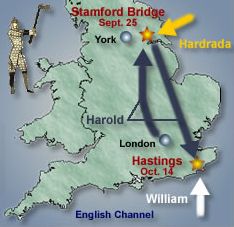
Personally, I’m quite angry with King Harold II. He should have won the Battle of Hastings, or at the very least made sure that defeat at that battle did not mean conquest by the Normans.
Harold was in a strong position following the astounding victory over Harold Hadarada at Stamford Bridge, in Yorkshire. Particularly, if Harold Had not rushed to confront William, but rested and gathered his troops. This would have allowed his troops to recover and give time for fresh troops to join him .See my posts on the Battle of Stamford Bridge and the Battle of Fulford.
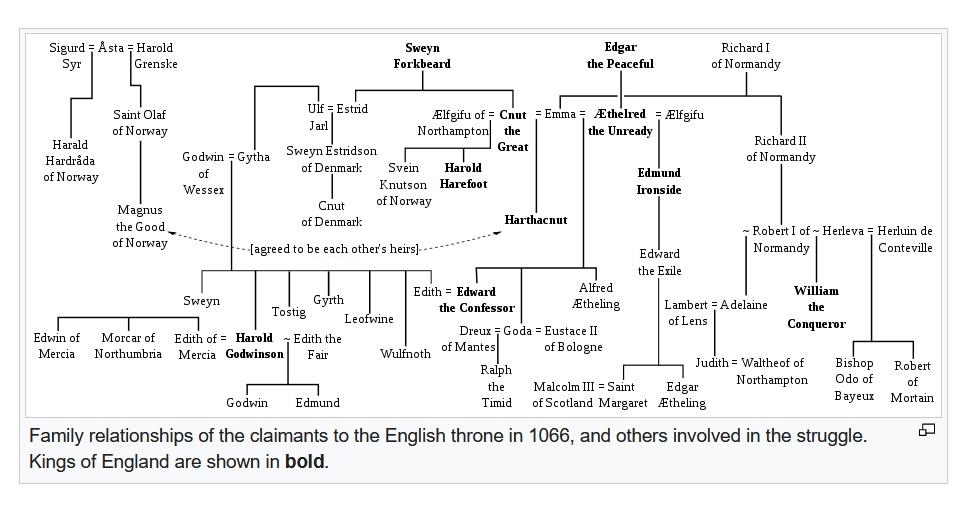
While waiting, Harold could have arranged the harrying of William’s army. Attacked their supply lines, increasing their anxiety, and sapping their resolution. When Harold had reached maximum strength, then would be the time to take on the weakened Norman Army.
But also, he should have had a succession plan. What would happen if he lost the battle? Who was to succeed him? As it was, he took his two brothers with him to the Battle, where all three of them died, leaving no clear adult heir to the throne. The English soon surrendered to William after the Battle of Hastings, precisely because there was no clear adult successor, unless that person was William himself.
Why did the English surrender to William?
Given the catastrophe for the English ruling class that William inaugurated, it’s difficult to understand why the English magnates decided to accept William as King. But let’s have a shot at looking at it from their perspective, they remembered that the reign of King Cnut, a Dane, created a successful fusion of English and Danish culture that was more stable than that of the weak English King Edward the Confessor. So, recent history taught: better a strong foreign King than a weak English King.
They were not to know that William would ensure that virtually all English nobles, church leaders, language and culture, would be swept aside and replaced by Norman and French alternatives. England would never be the same.
The Battle of Hastings
As to the Battle itself, there is no definitive account of what happened. We don’t know the composition of the armies nor their number. Estimates vary from 7,000 to over 20,000. But it was a ferocious battle which lasted all day and was often in the balance.
Harold fought the battle early, probably for 2 main reasons. Firstly, he had won the Battle of Stamford Bridge with the same tactics of fighting immediately after a long march, surprising the enemy and winning an overwhelming victory. Secondly, William had landed on Harold’s own personal land and Harold would not have easily borne a foreign power devastating his people.
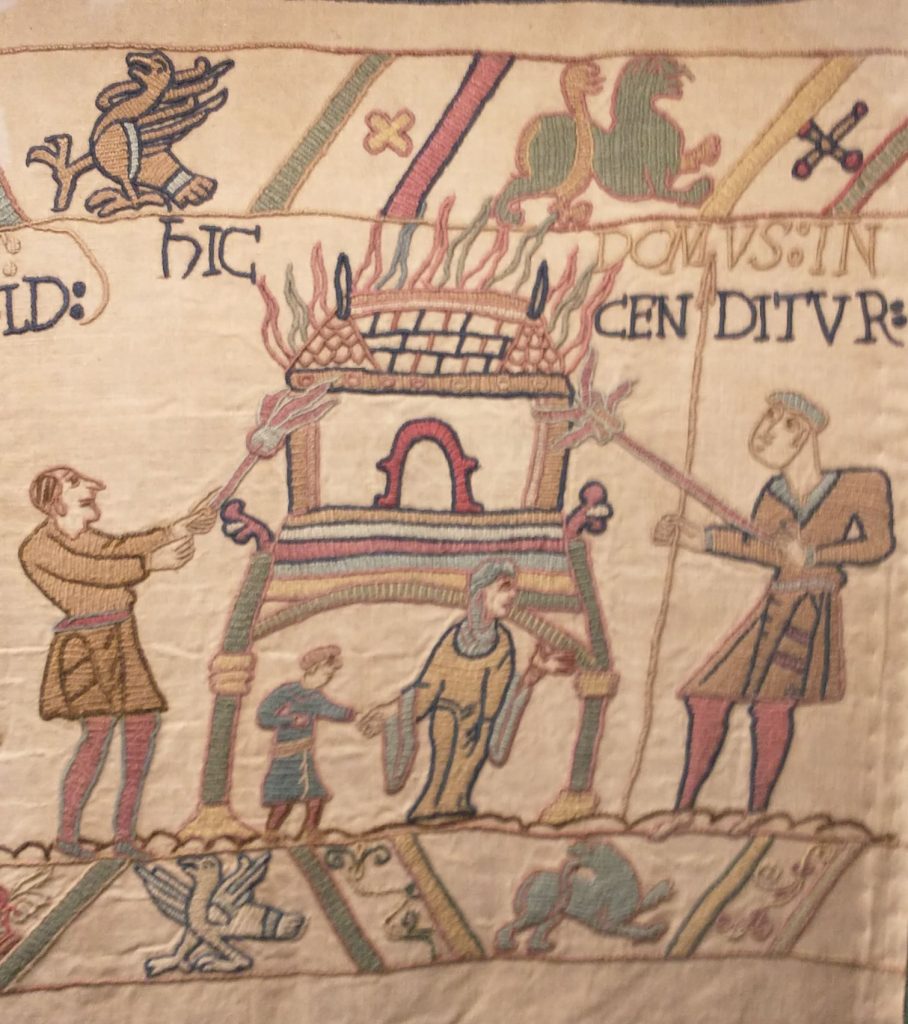
Reading Museum copy of the Bayeaux Tapestry Photo Kevin Flude
So, he matched as quickly as he could from London to Senlac near Hastings, where Battle Abbey would be later sited. He chose the top of a ridge, with a stream or ditch in front of it. William accepted battle and fighting began early in the day. Troops were still arriving to reinforce Harold. All he needed to do was hold his ground till dark and reinforcements would probably have made William’s position untenable.
Harold would have established his shield wall, although there are suggestions this was done while the Normans attached.
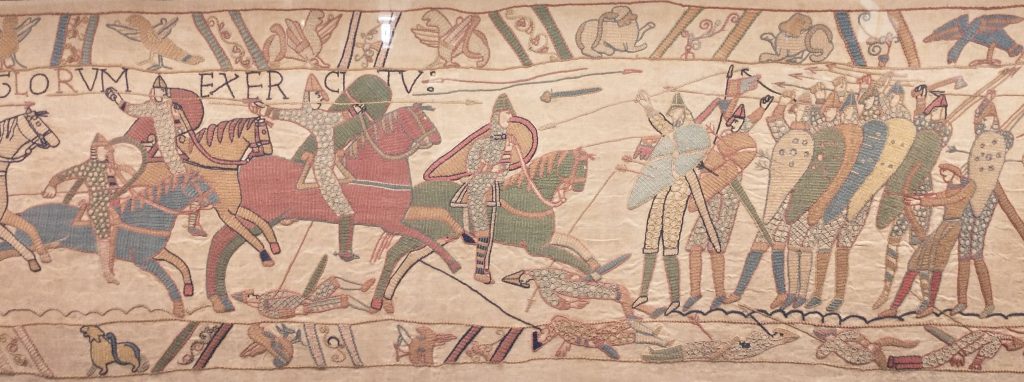
Reading Museum copy of the Bayeaux Tapestry Photo Kevin Flude
Harold seems to have held the ground until late afternoon. There are suggestions that his army was weakened by their rash pursuit of the retreating Normans down the hill. The Normans thought William was killed but he showed his face to reassure his troops, rallied his troops and turned on the English who, without the protection of their shield wall and the high ground, were badly mauled. The Normans renewed their attack.
At some point Harold’s brothers were killed, followed by Harold himself, possibly after being injured in the face by an arrow, but that is not proven.
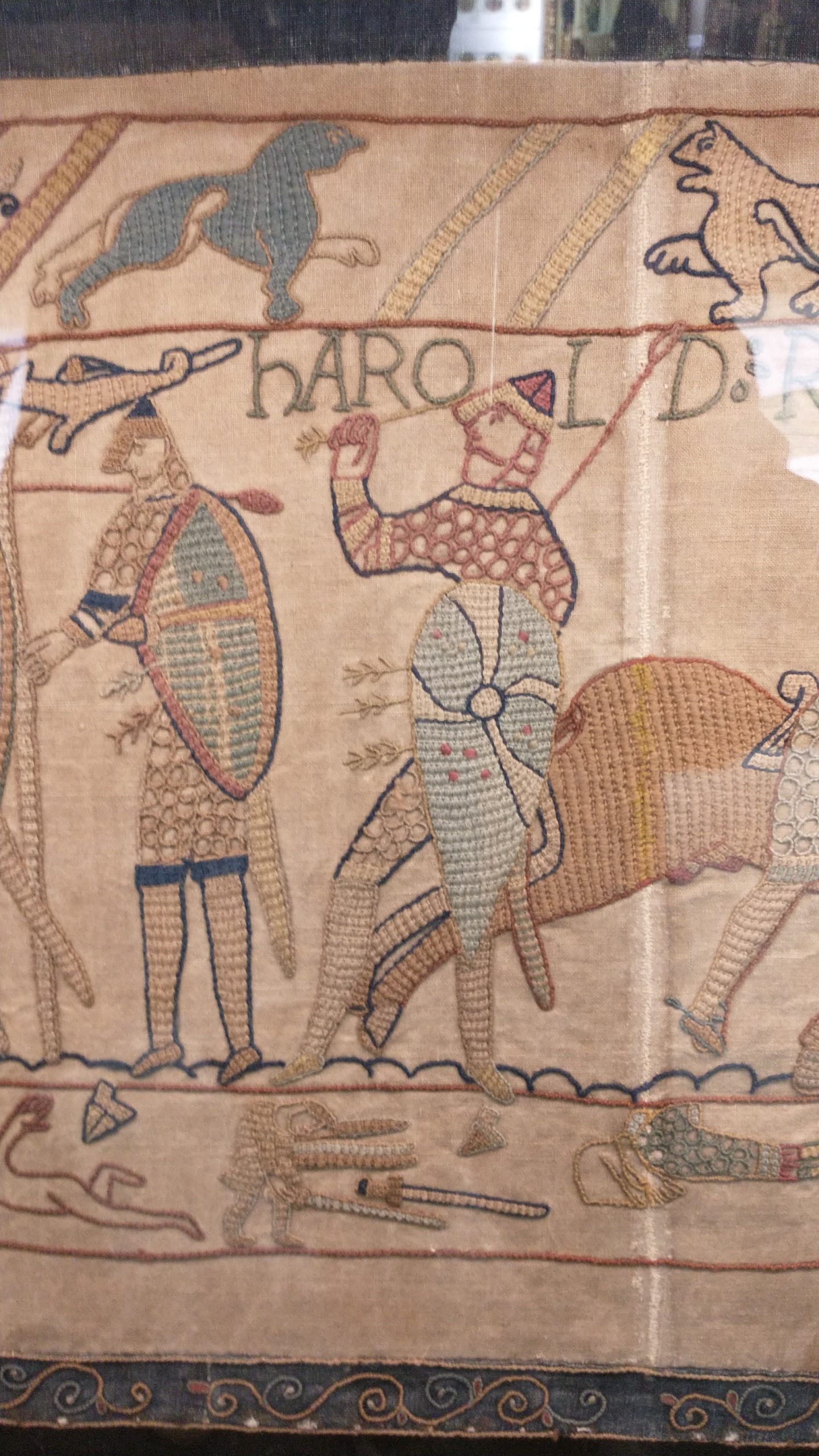
Reading Museum copy of the Bayeaux Tapestry

Reading Museum copy of the Bayeaux Tapestry
As darkness fell the English retreated, pursued by the Normans. The English fled back to London. In the following days, the Normans attached London Bridge, but Londoners stoutly defended the Bridge. They were led by the Portreeve Ansgar. He h ad been wounded at Hastings and was carried in a litter during the siege. The Portreeve was the King’s official in London, similar to a Shire Reeve. He also had the Danish title of ‘Staller’. The next day the Witangemote met in London and elected Edgar the Atheling as King. He was a nephew of Edward the Confessor, but only about 14 years old.
The Normans retreated from London and proceeded to harry the South, trying to find a crossing point over the Thames. We will return to the story in the following weeks.

Charlie Watts and the Bayeaux Tapestry
Charlie Watts owned a 19th Century reproduction of the Bayeaux Tapestry and this has recently been sold. It was photographed by a V&A photographer. ( To see more follow the link below.
The Tapestry is also coming to the UK on exhibition at the BM in 2026
On This Day
1586 Mary, Queen of Scots put on trial accused of Treason
1964 Martin Luther King wins Nobel Peace Prize. (see also my page on his visit to St Pauls Cathedral)
First Published in 2024, revised 2025
I went to the Stratford-upon-Avon Mop on October 12th

This year the Stratford Mop fair was on the 11th and 12th October, and I was there to see it!As I reposted a long post about the Mop a couple of days ago, I thought I should report back. To recap, the Mop began as a Michaelmas (Old Style) Hiring Fair, and has continued in Stratford ever since. But the modern incarnation is no longer a Hiring Fair and no shepherds were to be seen.

The centre of the Town was crowded with a cacophony of shooting galleries, games to win soft toys, stalls selling toffee apples, candy floss, burgers, and all things bad for you. And interspersed with the stalls were all sorts of rides, carousels and all the raucous fun of the fair.

You might have noticed I have labelled the photographs differently, one Stratford-upon-Avon, the other Stratford-on-Avon. Most prefer the ‘upon’ but I thought this wrong as the Council building in Church Street uses the simpler ‘on’. Having looked it up, I see that the answer is both are correct. Stratford-upon-Avon is used for the Town, and Stratford-on-Avon for the Town and area around the town. Now you know!
Now, I cannot find any reference in Shakespeare to a funfair, and all references to a Mop, are to the thing you mop the floor with. But he does mention St Bartholemew’s Fair obliquely, and certainly knew his friend, Ben Jonson’s Play ‘St Bartholemew’s Fair’. It is a great play based in London, at the annual fair in Smithfield. It was one of the great Wool fairs of England. It was held every year on St Bartholemew’s Day August 24th, and lasting sometimes weeks long. Please read my post on Bartlemas here.
Going to the Mop in Stratford-upon-Avon & Henley-in-Arden 11th & 12th October

This year the Stratford mop festival was on the 11th and 12th October. I am in Stratford. The the centre of town is a cacophany of shooting galleries, stalls selling toffee apples, candy floss, burgers and all things bad for you. And a fun fair.Nothing at all sophisticated, or literary or dramatic, or folkloric. Just a good old-fashioned fun fair in the middle of the town. Quite raucous, but they leave Henley Street, and Shakespeare’s’ Birthplace, free of it. Below I tell the story of my discovery of the Mop.


In 2023, I was on my way to Stratford-upon-Avon Railway station, I saw the sign at the top of this page, but had no idea what on earth a Mop was. I put it to the back of my mind as I took the train to Henley-in-Arden. My interest in the town was that Shakespeare was born in Henley St. And his mother was called Mary of Arden. So, naturally, I wanted to find out about Henley-in-Arden. To turn curiosity to action, it took our Tour Coach Driver telling me he lived there and that it was a pretty but small town.
Mary Arden doesn’t live here any more!
I had a free afternoon from my duties as Course Director on the ‘Best of England’ Road Scholar trip. I got on the very slow train to Henley-in-Arden. One of the first stops was Wilmcote, where Mary Arden’s House is. I visited two years ago, when I was astonished to find it was a different building to the one I had visited in the 1990s! In 2000, they discovered they had been showing the wrong building to visitors for years! Mary Arden’s House was, in fact, her neighbour Adam Palmer’s. And her house was Glebe Farm.
On that visit, I walked from Stratford-upon-Avon to Anne Hathaway’s Cottage. Then to Mary Arden’s House and back to Stratford along the Stratford Canal. It is a lovely country walk if you are ever in the area.
The Forest of Arden
The train route to Henley is through what remains of the ancient forest of Arden. The forest features in, or inspired, the woody Arcadian idylls which feature in several of Shakespeare’s plays, particularly the Comedies. ‘As You Like It’, for example, is explicitly set in the Forest of Arden, as this quotation from AYL I.i.107 makes clear:
Oliver: Where will the old Duke live?
Charles. They say he is already in the Forest of Arden, and a many merry men with him; and there they live like the old Robin Hood of England: they say many young gentlemen flock to him every day, and fleet the time carelessly as they did in the golden world.

Henley-in-Arden
Not much remains of the old Forest. It was cut down to make timber-framed buildings and ships for the British Navy – the so-called Wooden Walls. Henley has a beautiful high street. Further down the road is a lovely Heritage Centre full of old-fashioned and DIY Information panels. And that is not a criticism, it provided a very enjoyable visit full of interesting stuff. And gave me a couple of snippets of information I have not seen anywhere else.
One, was a panel dedicated to the Henley Mop. A mop turns out to be a hiring fair. Think of Gabriel Oak in Hardy’s ‘Far from the Madding Crowd’. His attempt to become an independent farmer destroyed when his sheepdog runs amok. The dog sends his sheep over a cliff to their doom. So he takes his shepherd’s crock to the hiring fair or Mop as they are known in the Midlands. There, potential employers can size up possible employees and strike mutually agreeable terms and conditions. And Gabriel becomes the shepherd for the delightful and wilful Bathsheba Everdene.
So, a shepherd would take his staff, or a loop of wool. A cleaner her mop (hence the name of the fair). A waggoner a piece of whipcord. A shearer their shears etc. Similarly, in the Woodlanders (by Thomas Hardy) the cider-maker, Giles Winterborne, brings an apple tree in a tub to Sherborne, to advertise his wares.
The retainers thus employed would be given an advance and would be engaged, normally, for the year. So there was quite a widespread moving around of working people to new jobs and often new housing. Not quite how we imagine the past?
The perceptive among you will have noted the bottom of the sign in Stratford which advertised the ‘Runaway Mop’. This was held later in the year, so that employers could replace those who ran away from their contracts. And those who ran away could find a better, kinder or more generous boss. See also my post of Gabriel Oak and Pack Rag Day which is another hiring fair which was help on Martinmas Old Style.
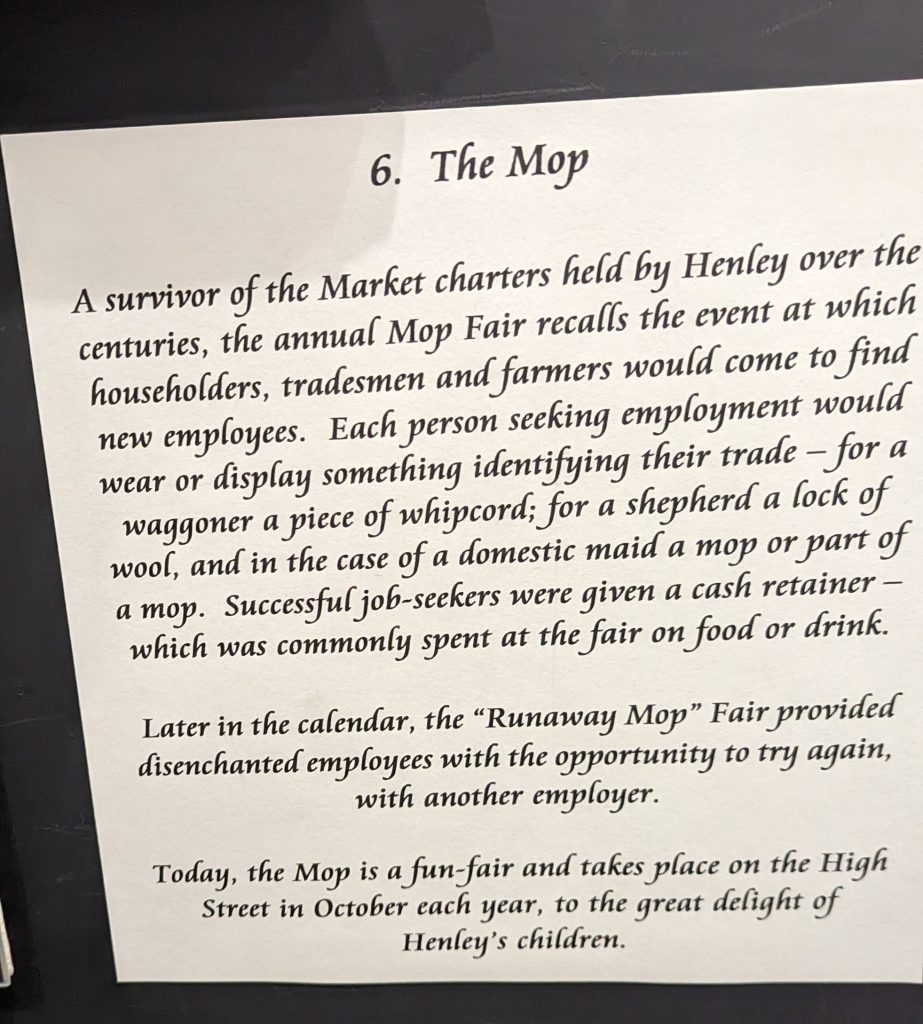
Court Leets and Barons
Also of interest to me was the panel about Court Leets and Barons. These were the ancient courts which dealt with, respectively, crime and disorder, and property and neighbourhood disputes. Henley still has its ancient manorial systems in use, at least ceremonially. The Centre shows a video of the installation of a new Lord of the Manor at the Guildhall. The title had been purchased by a cigar-smoking Stetson-wearing large rich American.
Johnson’s Coaches
Another panel was the story of a Coaching Company. When I lead the Best of England programme we are driven around by Johnson’s Coach Company. It was a delight to discover that it has a history that can be traced back to 1909 in Henley. I conveyed this information to our group on the next day as we toured the Cotswolds. Curtis, our driver, was able to update the panel. He told us that the family were still involved with the firm, which is still operating from the area. He said the two brothers who run the company come in every working day. They do everything they require of their drivers to do; i.e. they drive coaches, clean coaches, sweep the floors and generally treat their staff like part of a big family. I should have asked him whether he got his job at the Mop, while holding a steering wheel in his hands!

Note: It seems that Johnson has now merged with another company. But it keeps its depot in Henley and maintains its connection with the town.
First published in 2023 updated 2024, 2025
Michaelmas Old Style – October 11th

I am catching up as I have been away. So I’m a little behind in my days.
October 11th is the day that the Devil fell out of heaven and landed in a Blackberry Bush. So. you are, therefore, not wise to eat them after October 11th. St Michael’s Day is now celebrated on September 29th (see my post here). But before September 1752, it was celebrated on what is now October 11th, now styled ‘Michaelmas Old Style’. The change of date is due to the introduction in the UK of the Gregorian Calendar.
Saint Michael is the chief of the archangels. Saint Gabriel was celebrated on the eve of the Annunciation on 24 March (see my post here). St Raphael on the 24th October, But more recently the Churches celebrate all the Archangels at Michaelmas. It is now called the celebration of St Michael and All Angels.
Terms. Colleges, Lawyers and Quarterdays
Apart from its religious significance, St Michael’s Mass was an important date on the civic calendar. Terms began, rent fell due, and work contracts ran out. It was the end of the ploughman’s year, and the day when Hiring Festivals or Mop Festivals took place. Look at my post on the Stratford Mop festival
So in Oxford, the autumn term is called Michaelmas. The Spring Term Hilary on St Hilary’s Festival of January 14th. The third term is called Trinity, which takes place on Trinity Sunday the first Sunday after Pentecost. The law courts also have a Michaelmas term.
It is one of the Quarter Day’s of the year, close to the Solstices and the Equinox into which the medieval and early modern world was divided:
- Lady Day (25 March, the Feast of the Annunciation)
- Midsummer Day (24 June, the Nativity of St John the Baptist)
- Michaelmas (29 September, the Feast of St Michael and All Angels)
- Christmas (25 December)
(The above list is copied from Wikipedia).
Eat a Goose for Good luck at Michaelmas
It is probably too late to tell you this year. But “if you eat goose on Michaelmas Day you will never lack money all year“. Or as they said in Yorkshire: ‘He’at eateth goose on Michaelmas won’t find his pockets short of brass.’ Jane Austen wrote to Cassandra on Michaelmas 1813 ‘I dined upon goose today, which I hope with secure a good sale of my second edition.’ Pride and Prejudice was published in 1813.
St Michael is one of several archangels. He was protector of the Israel. He has four main roles in heaven. He is the leader of the heavenly host in its defeat of Satan. He is the Angel of Death, the Weigher of Souls, and the Guardian of the Church. For more on archangels, see the second half of my post on Michaelmas here.
On this day
The Romans celebrated ‘meditrinalia’ where they celebrated the new wine and the Gods that made it possible. They toasted the wine chanting:
‘I drink old and new wine to cure old and new disease.’
First Published in 2024, revised in 2025
